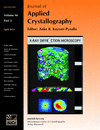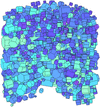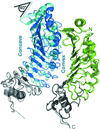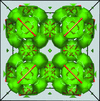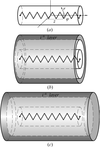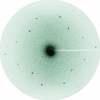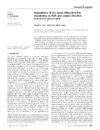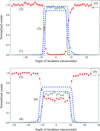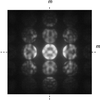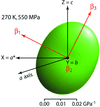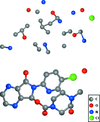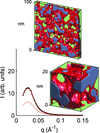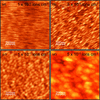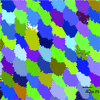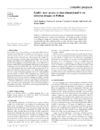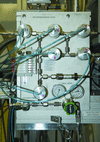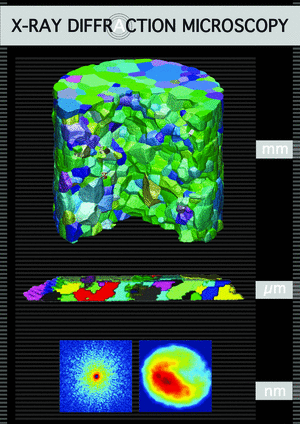issue contents
April 2013 issue

Cover illustration: Structures of polycrystals and of a Schizosaccharomyces pombe spore at different length scales. Courtesy of Reischig et al. [J. Appl. Cryst. (2013), 46, 297-311], Larson & Levine [J. Appl. Cryst. (2013), 46, 153-164] and Rodriguez et al. [J. Appl. Cryst. (2013), 46, 312-318].
editorial
Free 

In anticipation of the International Year of Crystallography in 2014, Journal of Applied Crystallography presents a virtual issue on recent developments in X-ray diffraction microscopy. This issue is available at //journals.iucr.org/special_issues/2013/imaging/.
research papers
Recent developments in the use of the diffraction contrast tomography method to create three-dimensional grain maps of polycrystalline samples are described. These include the use of detectors in arbitrary positions, including high Bragg angles, and the application to multiphase materials.
Oversampling smoothness: an effective algorithm for phase retrieval of noisy diffraction intensities
An iterative phase retrieval algorithm, termed oversampling smoothness (OSS), has been developed to reconstruct fine features in weakly scattered objects such as biological specimens from noisy experimental data. OSS is expected to find application in the rapidly growing coherent diffraction imaging field as well as other disciplines where phase retrieval from noisy Fourier magnitudes is needed.
A new experimental method for sub-pixel resolution of speckle patterns is presented. It allows upsampling of undersampled diffraction patterns necessary for subsequent real-image reconstruction with an iterative phase-retrieval algorithm.
Structural and dielectric investigations were carried out on a perovskite lead-free (Ba1−xCax)(Zr0.05Ti0.95)O3 ferroelectric ceramic for x = 0.03, 0.05, 0.08, 0.10, 0.12 and 0.15.
The application of the atomic pair distribution function for the purpose of obtaining the crystalline and amorphous phase fractions of samples with unknown phase ratios is demonstrated. The resolution of the method is established with a set of standards and recommended best practices are discussed.
Open  access
access
 access
accessThe observation of a repetitive pattern obtained for protein crystals formed by reaction–diffusion in capillary tubes is reported for the first time.
Download citation


Download citation


A new metal–organic framework-specific method for structure envelope construction is proposed. Structure solution from powder X-ray diffraction data of metal–organic frameworks has been demonstrated on activated and as-synthesized samples of HKUST-1 and an activated sample of PCN-200.
The capabilities of two techniques for extending the range of conventional small-angle neutron scattering (SANS) towards the micrometre length scale are compared, namely double-crystal diffraction ultra-small-angle neutron scattering (DCD USANS) and spin-echo SANS (SESANS).
Open  access
access
 access
accessA method is presented and applied, capable of retrieving form-free particle size distributions complete with uncertainties from small-angle scattering patterns. Special attention is paid to particle observability in the scattering patterns, accurate estimation of data uncertainty and the effect of uncertainty on the resulting size distribution statistics.
The method of classical molecular dynamics simulation is used for modeling the experimental small-angle neutron scattering from saturated monocarboxylic acids with short chain lengths in deuterated decalin solutions. It is shown that a specific organization of the solvent molecules in the solute–solvent interface area has a significant effect on the scattering.
Bi2Sr2CaCu2O8+δ (Bi2212) thin films with excellent superconducting properties were prepared by the Pechini sol–gel method using nitrates as reactants.
Indexing of multi-particle diffraction data in a high-pressure single-crystal diffraction experiment
A method has been proposed for the indexing of multi-particle diffraction data, in which the techniques of powder pattern indexing and genetic algorithms are applied in sequence to determine the orientation matrix.
A model describing the dependence of the strain diffraction line breadth on direction in both crystal and sample is derived. The model is appropriate for implementation in Rietveld programs.
The morphology and real structure of wurtzite-type ZnO nanospikes grown by the recently introduced flame transport synthesis have been examined by means of advanced transmission electron microscopy. The observed nanospikes show a complicated superposition of twinned domains as an intrinsic real structural feature.
A new method for reconstruction of the interatomic distance distribution, P(r), directly from two-dimensional detector images of solution scattering data is developed and tested. This method employs Bayesian inference and a Markov chain Monte Carlo method to simultaneously estimate indirect transform coefficients and beam and detector parameters, while also evaluating the covariance among all parameters.
A model is proposed to calculate the diffraction efficiency of X-rays in Laue geometry for curved crystals with an arbitrary value of the curvature radius. The model generalizes the results based on the dynamical theory of diffraction, which are valid only for crystals with a radius of curvature lower than the critical curvature.
A high magnetic field has a significant microstructural and crystallographic effect on the primary Al3Zr phase precipitated during the solidification of an Al–Zr alloy.
Electron diffraction characterization of a new metastable Al2Cu phase in an Al–Cu friction stir weld
The space group of a new metastable orthorhombic Al2Cu phase was unambiguously identified as Ic2m by a recently developed systematic method combining precession electron diffraction and convergent-beam electron diffraction.
The formation of inversion domain boundaries on the growth fronts of laterally overgrown domains induced spontaneously regulated inversion of in-plane polarity of a-oriented GaN domains, which is reported for the first time.
A thermal equation of state for the deuterated analogue of mirabilite has been fitted to high-pressure neutron powder diffraction data and used to obtain a range of thermodynamic quantities required for modelling the structure and dynamics of icy satellite interiors.
An exact and explicit expression of the pair distribution function as obtained from X-ray total scattering is derived with respect to partial functions.
A complete grazing-incidence X-ray scattering (GIXS) formula was derived for nanopores buried in a polymer dielectric thin film supported by a substrate. Using the GIXS formula, the scattering data from the nanoporous dielectric films were comprehensively analyzed, revealing structural details.
RAMM: a new random-model-based method for solving ab initio crystal structure using the EXPO package
A new method, based on the generation of random structure models, is proposed for solving ab initio crystal structures from powder diffraction data.
The evolution of local misorientations, orientation gradients and grain boundary distribution during thermomechanical processing of zirconium samples is studied using the electron backscatter diffraction technique, kernel average misorientation and grain orientation spread statistics, and the proposed novel approach of grain boundary analysis.
In situ synchrotron small-angle X-ray scattering is used to investigate wetting transitions of liquids confined in disordered mesoporous materials. A plurigaussian stochastic model is proposed, which enables one to analyze the data in terms of changing interface areas, contact angle and triple-line length.
Depth profile investigation of Fe-implanted Si(100) has been carried out using extremely asymmetric X-ray diffraction. Owing to its higher surface sensitivity compared to X-ray reflectivity, a decrease of the mass density close to the surface was found for increasing ion fluence, which is explained by the formation of ion-induced near-surface defects.
An adaptive forward modeling orientation reconstruction algorithm is presented and illustrated. Combined with near-field high-energy X-ray diffraction microscopy measurements, the algorithm reconstructs maps of crystallographic orientations in polycrystals that include intra-granular orientation gradients, which arise in many applied materials.
cryocrystallography papers
Several commercial sample mounting loops are tested for rigidity using silicon single crystals. Final testing is performed using crystals of tetragonal lysozyme to look for motion under typical data collection conditions.
computer programs
A Python module for reading and handling data from two-dimensional X-ray detectors is presented.
A new program, CLUSTERGEN, for molecular cluster generation is introduced. CLUSTERGEN provides the quantum mechanics/molecular mechanics input files for program packages such as ADF or GAUSSIAN and, in general, facilitates file-format manipulation.
The new open-source GSAS-II package is intended to offer all stages of crystallographic analysis on all types of X-ray and neutron single-crystal and powder diffraction data.
The CTEAS software for calculating thermal expansion of crystalline materials in three dimensions is presented.
Programs for visual and automatic detection of alternative conformations in protein structures are presented. The detection procedure is based on features of atomic mobility in unrestrained refinement.
This paper presents the PDFgetX3 program for extracting an atomic pair distribution function from X-ray powder diffraction data.
laboratory notes
A sample preparation technique has been developed to enable the safe measurement of radioactive powders on the high-resolution powder diffraction beamline, ID31, at the European Synchrotron Radiation Facility.
A new rig at the European Synchrotron Radiation Facility for dosing fixed pressures of absorbent gas up to 100 bar (107 Pa) into a powder sample is described. The system is fully integrated into the beamline control software.
A novel type of X-ray collimation system attached to commercial powder diffractometers makes the structural characterization of nanomaterials possible in a wide size range from <0.1 to 100 nm by combination of the small- and wide-angle X-ray scattering techniques. This device can be attached to any existing `θ/θ' powder diffractometer, providing a multi-functional small- and wide-angle X-ray scattering/diffraction apparatus.
Window materials for small-angle X-ray scattering measurements have been evaluated using a vacuum camera. It is shown that window materials vary in how they scatter the background signal depending on the q range.


 journal menu
journal menu








